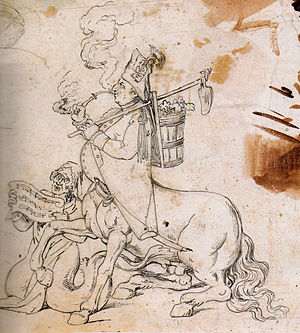Caricature of the supervisor Lieutenant Johann Niess

|
| Caricature of the supervisor Lieutenant Johann Niess |
|---|
| Joseph Anton Koch , around 1790/1805 |
| drawing |
| 24.2 x 22.3 cm |
| State Gallery Stuttgart, Graphic Collection |
The caricature of the supervisor Lieutenant Johann Nieß is the work of the artist Joseph Anton Koch .
background
Joseph Anton Koch was educated at the High Charles School and, like many of the students, suffered from the strict regulations and constant supervision that the students were under. One of the monitors was supervisor Johann Niess. Nieß was born in Bolheim in 1729 and took part in the campaign to Bohemia as a soldier. At the Battle of Leuthen he was taken prisoner of war in Prussia, which the Peace of Hubertusburg ended. He was then employed by Duke Carl Eugen von Württemberg's nursery school and in 1773 appointed lieutenant by him. His tasks included bringing reports to the director, monitoring the entry of the pupils into the dining room and, above all, carrying out rounds of inspections through the academy in order to prevent or uncover prohibited actions. In one of Schiller's biography , Nieß is described as follows: He had "an" esprit de detail "and an unparalleled hustle and bustle, but also led a command that one hardly dared to breathe in his presence. Nevertheless, his small, fat, almost conical figure was the target of all the teasing on the part of the pupils, and there was no greater fun for them than when they succeeded in beating the supervisor quite well. ”Nieß, who also in Heinrich Laube's play The Karlsschüler occurs died in 1808.
description
Joseph Anton Koch's pen drawing shows the supervisor in the form of a centaur with a pipe in his mouth and a wine vat on his back. These two attributes bear witness to Nieß's well-known predilection for alcohol and bad tobacco. The latter meant that Nieß was rarely able to approach the students unnoticed, since the smell gave him away. The massive horse's body, from which Nieß's upper body, clad in uniform and saber, grows, turns its left side towards the viewer. The hind legs are bent in an almost sitting position, the wavy tail seems to be half on the ground. The left front leg is stretched out and pushed forward a little, the right one, whose hoof seems to be the only one shod, is raised. Nieß's left hand holds the handle of a gardening tool, which lies over his left shoulder and on which the vat filled with grapes hangs, with his right he holds his pipe, from whose head as well as from his mouth or nose thick clouds of smoke rise . On the right side of the centaur figure and partly covered by its forelegs, another mythological figure kneels, a kind of water mermaid with probably a split fish tail, which winds its way under the centaur's belly and seems to touch it on the left side, just before the genitals. The figure wears a robe on the upper part of the body, part of which hangs down on the floor in front of her lap and which has long, apparently cuffed sleeves, as well as a kind of hood on the head and a pince-nez on the strong, curved nose. In her hands she holds a sheet of music from which she seems to be singing something. In contrast to the sneeze drawn in profile, her face is almost completely turned towards the viewer.
While this water being could not be interpreted so far, is easy to understand why cooking Nieß has shown in Kentaurengestalt: The appeal of his surname the name of the centaur Nessus is not just a play on words , but allowed the artist at the same time himself with Heracles to identify who suffered such agony from an item of clothing poisoned by Nessos that he eventually took his own life.
The sheet is in the graphic collection of the Staatsgalerie Stuttgart and bears the inventory number C 89/3610.
Individual evidence
- ↑ Eduard Boas, Schiller's Jugendjahre , first volume, Hanover 1856, p. 23 (PDF; 526 kB)
- ^ Sabine Rathgeb, Annette Schmidt, Fritz Fischer, Schiller in Stuttgart , Württembergisches Landesmuseum Stuttgart 2005, ISBN 3-929055-63-5 , p. 127